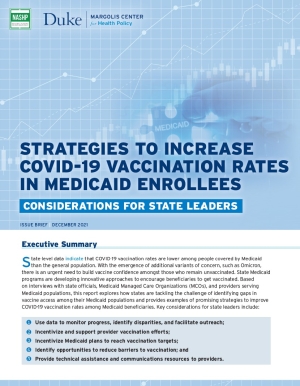
Policy Brief
Strategies to Increase COVID-19 Vaccination Rates in Medicaid Enrollees
Published date
Data indicate that COVID-19 vaccination rates are lower among people covered by Medicaid than the general population in many states. With the development of additional variants of concern, such as Omicron, there is an urgent need to build vaccine confidence amongst those who remain unvaccinated. State Medicaid programs are developing innovative approaches to encourage beneficiaries to become vaccinated. Based on interviews with state officials, Medicaid Managed Care Organizations (MCOs), and providers serving Medicaid populations, this report explores how states are tackling the challenge of identifying gaps in vaccine access among their Medicaid populations and provides examples of promising strategies to improve COVID-19 vaccination rates among Medicaid beneficiaries. Key considerations for state leaders include:
- Use data to monitor progress, identify disparities, and facilitate outreach;
- Incentivize and support provider vaccination efforts;
- Incentivize Medicaid plans to reach vaccination targets;
- Identify opportunities to reduce barriers to vaccination; and
- Provide technical assistance and communications resources to providers.
Duke-Margolis Affiliated Authors

Katie Huber, MPH
Policy Research Associate

Mark McClellan, MD, PhD
Director of the Duke-Margolis Institute for Health Policy
Robert J. Margolis, MD, Professor of Business, Medicine and Policy
Margolis Executive Core Faculty
